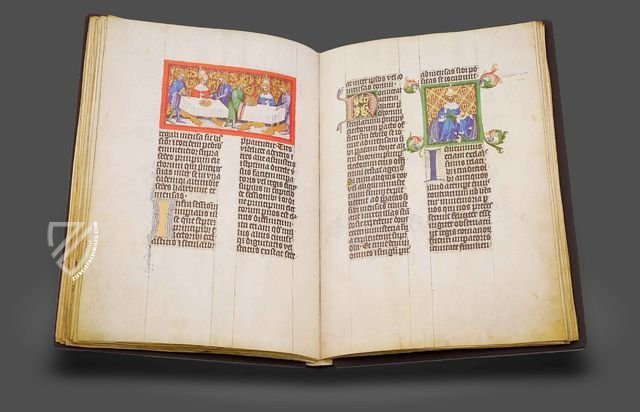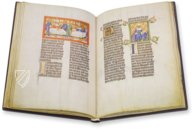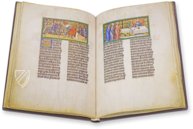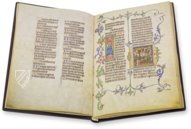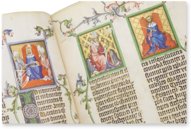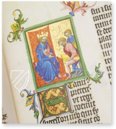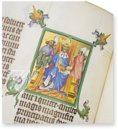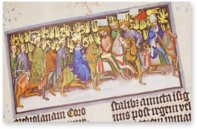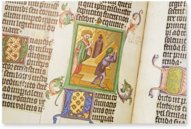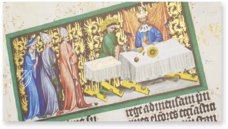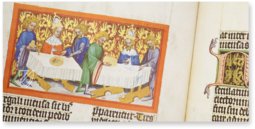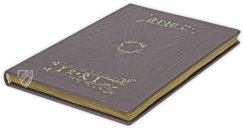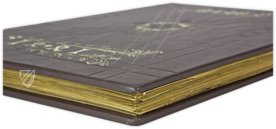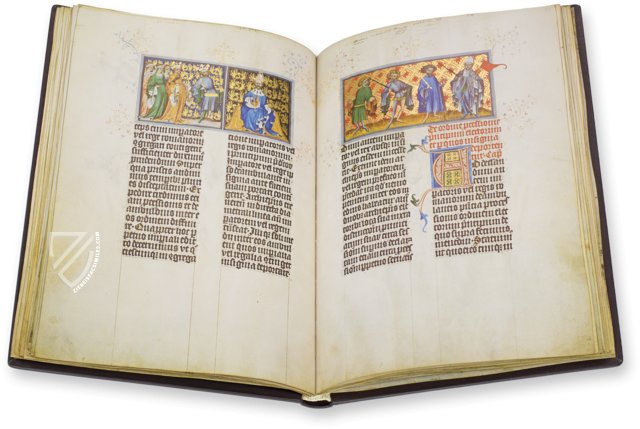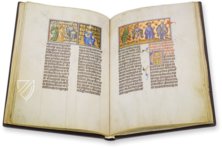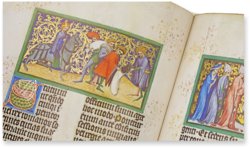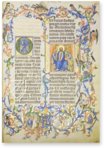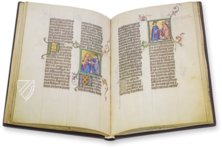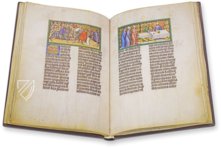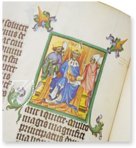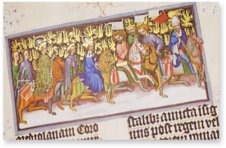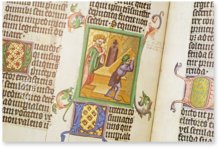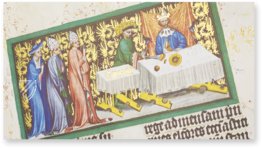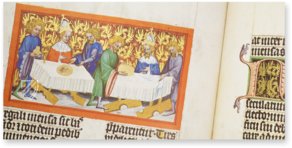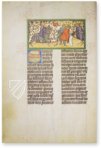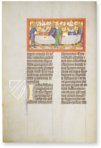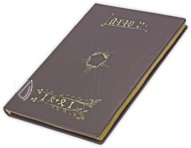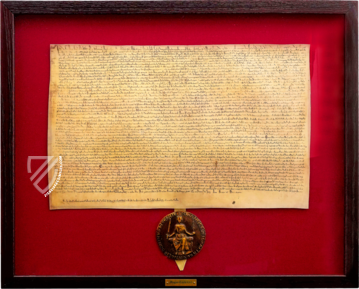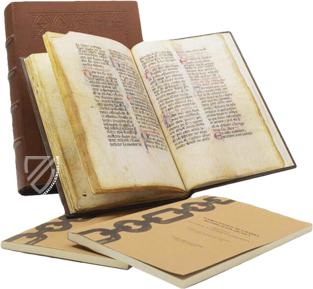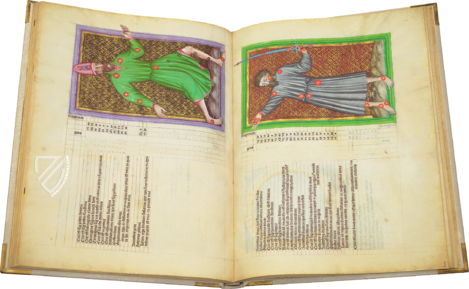Golden Bull
(3,000€ - 7,000€)
This magnificent illuminated manuscript was wrapped up in the political turmoil ca. 1400 and was intended as a form of medieval propaganda by King Wenceslas of Bohemia. The Vienna Codex 338 is a copy of the Golden Bull and is of prime historical and political significance, not to mention its masterful calligraphy and adornment. The Golden Bull, promulgated in 1365 by Emperor Charles IV with the consent of two diets in Nuremberg and Metz, represented the main constitutional law of the German Empire and, as a basic constitutional law, remained in force for nearly half a millennium, up until 1806. This edition is noteworthy for its incredible initials in particular, which are arguably the finest in medieval illumination and even take the form of figural miniatures at two important places in the text.
The Golden Bull
The Vienna Codex 338 is a copy of the Golden Bull made in 1400 with illumination of superior quality. It is therefore considered to be the most beautiful version of all manuscripts of this text that have survived to this day. From an artistic point of view, the luxurious manuscript belongs to the tradition of Bohemian book painting. Its 48 miniatures and countless colored initials enchant the beholder even today. The uniformity of the written script as well as the text layout contribute to the outstanding beauty of the manuscript and, together with the miniatures and initials, form a harmonious ensemble. The manuscript is a document of prime importance also on a political and historical level, due to the finishing touch stating that it was made in the year 1400 on the initiative of the Roman and Bohemian King Wenceslas. The ceremonial copy was meant to legitimate Wenceslas’ claim to the office of King of the Romans which had just been withdrawn from him, and also the most eminent document in the negotiations with the Pope regarding the coronation of the German Emperor in Rome.
The Finest Version of the Oldest German Constitution
The particular charm of the manuscript resides in its 48 sumptuous miniatures. They are considered to be the work of a single anonymous master known as ”Master of the Golden Bull”. The painted scenes all refer to the election of the emperor and the exercise of rights. The background of the miniatures is either applied with gold leaf or in color, and damascened with shell gold. The interlace surrounding the miniatures comprises acanthus leaves in blue, rose, green and grey. Here and there drop-shaped buds in gold leaf are playfully added to the branching foliage. The scenes of the Golden Bull are characterized by a festive atmosphere. An important feature is the painter’s predilection for exuberant plies and rounded forms, for strong and curly hair and strongly projecting noses. The beginnings of chapters and some paragraphs are marked by colored initials some of which are ornate with gold and elaborate interlace. A highlight of the art of initial painting, as practiced by specialized artists, is achieved with the integration of figural depictions. The initial in its most noteworthy artistic form thus becomes a figural miniature. This form of historiated initial occurs twice in the manuscript, both times to mark important passages in the text.
A Masterpiece of Calligraphy
The script of the codex also deserves great attention. It is a beautiful Gothic calligraphy (textualis formata or textura) written by an anonymous scribe. The chapter beginnings are all highlighted with red ink, while some at the beginning of the manuscript are outlined in golden letters in a highly representative manner.
A Prominent Source of History
The Golden Bull, promulgated in 1365 by Emperor Charles IV with the consent of two diets in Nuremberg and Metz, represented the main constitutional law of the German Empire and, as a basic constitutional law, remained in force for nearly half a millennium, up until 1806. Its main purpose was to regulate the election of the German Emperor. King Wenceslas IV, son of Emperor Charles IV, commissioned a copy in 1400 for political reasons, which was then produced in his famous court workshop. The luxurious Latin manuscript contains not only the Golden Bull after which it is named (aurea bulla imperialium constitucionum) but also a treatise on the appropriate time for an Italian campaign (tractatus de habilitate temporis ad processum versus Italiam), a letter on King Wenceslas, the successor of Charles IV, (epistola de successore), and a directory of cities and castles in Tuscia (civitates et castra). It is the only legal work among the seven known codices which have been confirmed as originating from the huge library formerly belonging to Wenceslas, including the famous Wenceslas Bible, the oldest German deluxe Bible manuscript we know of.
Codicology
- Alternative Titles
- Goldene Bulle
Goldene Bulle des Königs Wenzel - Size / Format
- 160 pages / 42.0 × 30.0 cm
- Origin
- Czech Republic
- Date
- 1400
- Epochs
- Style
- Language
- Script
- Gothic Textura
- Illustrations
- One large decorative page with richly ornamented margins, 50 miniatures in the text and numerous colorful initials with gold leaf
- Content
- The main constitutional law of the German Empire
- Patron
- Wenceslas IV (1361–1419), King of Bohemia and King of Germany
- Artist / School
- Master of the Golden Bull
Golden Bull
A Royal Feast
Presented before a patterned red background that is shimmering with gold leaf, we see two kings with elaborate crowns and robes trimmed with ermine being served a meal. The young, clean-shaven monarch on the left looks on graciously as his meat is being cut on a golden plate. An older bearded king on the right gestures toward a servant in green, who brings a covered dish, which is also gold. The servants are all depicted as young men with flowing blonde locks.

Golden Bull
Tax Collection
In a document concerned with the laws of the Holy Roman Empire, tax collection is naturally an important issue. Here we see the Duke of Saxony mounted on horseback in his role as imperial marshal, identifiable by his elector’s hat and staff. The men are paying their taxes “in kind”, specifically with oats, which are being poured into a bag.
One is immediately struck by the incredible color palette of the scene: radiant orange and green contrast with dark grays and blues. The characters have thick, curly hair and wear tights of alternating colors. The radiant background nearly outshines the scene itself and is distinguished by its gold leaf filigree pattern. Even the minimalistic frame stands out due to the pseudo-kelly-green color chosen for it.

#1 Die Goldene Bulle
Language: German
The comprehensive scholarly commentary by Armin Wolf offers an extensive history of the manuscript as well as a detailed description, comments and interpretations of the artistic decoration from an art historian’s point of view. It further explains the significance of the manuscript, provides a comprehensive bibliography, and a collection of pictures selected according to aspects of legal history which offer comparative material on the legal status of the Roman German Emperor and his electors.
(3,000€ - 7,000€)
- Treatises / Secular Books
- Apocalypses / Beatus
- Astronomy / Astrology
- Bestiaries
- Bibles / Gospels
- Chronicles / History / Law
- Geography / Maps
- Saints' Lives
- Islam / Oriental
- Judaism / Hebrew
- Single Leaf Collections
- Leonardo da Vinci
- Literature / Poetry
- Liturgical Manuscripts
- Medicine / Botany / Alchemy
- Music
- Mythology / Prophecies
- Psalters
- Other Religious Books
- Games / Hunting
- Private Devotion Books
- Other Genres
- Afghanistan
- Armenia
- Austria
- Belgium
- Belize
- Bosnia and Herzegovina
- China
- Colombia
- Costa Rica
- Croatia
- Cyprus
- Czech Republic
- Denmark
- Egypt
- El Salvador
- Ethiopia
- France
- Germany
- Greece
- Guatemala
- Honduras
- Hungary
- India
- Iran
- Iraq
- Israel
- Italy
- Japan
- Jordan
- Kazakhstan
- Kyrgyzstan
- Lebanon
- Liechtenstein
- Luxembourg
- Mexico
- Morocco
- Netherlands
- Palestine
- Panama
- Peru
- Poland
- Portugal
- Romania
- Russia
- Serbia
- Spain
- Sri Lanka
- Sweden
- Switzerland
- Syria
- Tajikistan
- Turkey
- Turkmenistan
- Ukraine
- United Kingdom
- United States
- Uzbekistan
- Vatican City
- A. Oosthoek, van Holkema & Warendorf
- Aboca Museum
- Ajuntament de Valencia
- Akademie Verlag
- Akademische Druck- u. Verlagsanstalt (ADEVA)
- Aldo Ausilio Editore - Bottega d’Erasmo
- Alecto Historical Editions
- Alkuin Verlag
- Almqvist & Wiksell
- Amilcare Pizzi
- Andreas & Andreas Verlagsbuchhandlung
- Archa 90
- Archiv Verlag
- Archivi Edizioni
- Arnold Verlag
- ARS
- Ars Magna
- ArtCodex
- AyN Ediciones
- Azimuth Editions
- Badenia Verlag
- Bärenreiter-Verlag
- Belser Verlag
- Belser Verlag / WK Wertkontor
- Benziger Verlag
- Bernardinum Wydawnictwo
- BiblioGemma
- Biblioteca Apostolica Vaticana (Vaticanstadt, Vaticanstadt)
- Bibliotheca Palatina Faksimile Verlag
- Bibliotheca Rara
- Boydell & Brewer
- Bramante Edizioni
- Bredius Genootschap
- Brepols Publishers
- British Library
- C. Weckesser
- Caixa Catalunya
- Canesi
- CAPSA, Ars Scriptoria
- Caratzas Brothers, Publishers
- Carus Verlag
- Casamassima Libri
- Centrum Cartographie Verlag GmbH
- Chavane Verlag
- Christian Brandstätter Verlag
- Circulo Cientifico
- Club Bibliófilo Versol
- Club du Livre
- CM Editores
- Collegium Graphicum
- Collezione Apocrifa Da Vinci
- Comissão Nacional para as Comemorações dos Descobrimentos Portugueses
- Coron Verlag
- Corvina
- CTHS
- D. S. Brewer
- Damon
- De Agostini/UTET
- De Nederlandsche Boekhandel
- De Schutter
- Deuschle & Stemmle
- Deutscher Verlag für Kunstwissenschaft
- DIAMM
- Droz
- E. Schreiber Graphische Kunstanstalten
- Ediciones Boreal
- Ediciones Grial
- Ediclube
- Edições Inapa
- Edilan
- Editalia
- Edition Deuschle
- Edition Georg Popp
- Edition Leipzig
- Edition Libri Illustri
- Editiones Reales Sitios S. L.
- Éditions de l'Oiseau Lyre
- Editions Medicina Rara
- Editorial Casariego
- Editorial Mintzoa
- Editrice Antenore
- Editrice Velar
- Edizioni Edison
- Egeria, S.L.
- Eikon Editores
- Electa
- Emery Walker Limited
- Enciclopèdia Catalana
- Eos-Verlag
- Ephesus Publishing
- Ernst Battenberg
- Eugrammia Press
- Extraordinary Editions
- Fackelverlag
- Facsimila Art & Edition
- Facsimile Editions Ltd.
- Facsimilia Art & Edition Ebert KG
- Faksimile Verlag
- Feuermann Verlag
- Folger Shakespeare Library
- Franco Cosimo Panini Editore
- Friedrich Wittig Verlag
- Fundación Hullera Vasco-Leonesa
- G. Braziller
- Gabriele Mazzotta Editore
- Gebr. Mann Verlag
- Gesellschaft für graphische Industrie
- Getty Research Institute
- Giovanni Domenico de Rossi
- Giunti Editore
- Graffiti
- Grafica European Center of Fine Arts
- Guido Pressler
- Guillermo Blazquez
- Gustav Kiepenheuer
- H. N. Abrams
- Harrassowitz
- Harvard University Press
- Helikon
- Hendrickson Publishers
- Henning Oppermann
- Herder Verlag
- Hes & De Graaf Publishers
- Hoepli
- Holbein-Verlag
- Houghton Library
- Hugo Schmidt Verlag
- Idion Verlag
- Il Bulino, edizioni d'arte
- ILte
- Imago
- Insel Verlag
- Insel-Verlag Anton Kippenberger
- Instituto de Estudios Altoaragoneses
- Instituto Nacional de Antropología e Historia
- Introligatornia Budnik Jerzy
- Istituto dell'Enciclopedia Italiana - Treccani
- Istituto Ellenico di Studi Bizantini e Postbizantini
- Istituto Geografico De Agostini
- Istituto Poligrafico e Zecca dello Stato
- Italarte Art Establishments
- Jan Thorbecke Verlag
- Johnson Reprint Corporation
- Josef Stocker
- Josef Stocker-Schmid
- Jugoslavija
- Karl W. Hiersemann
- Kasper Straube
- Kaydeda Ediciones
- Kindler Verlag / Coron Verlag
- Kodansha International Ltd.
- Konrad Kölbl Verlag
- Kurt Wolff Verlag
- La Liberia dello Stato
- La Linea Editrice
- La Meta Editore
- Lambert Schneider
- Landeskreditbank Baden-Württemberg
- Leo S. Olschki
- Les Incunables
- Liber Artis
- Library of Congress
- Libreria Musicale Italiana
- Lichtdruck
- Lito Immagine Editore
- Lumen Artis
- Lund Humphries
- M. Moleiro Editor
- Maison des Sciences de l'homme et de la société de Poitiers
- Manuscriptum
- Martinus Nijhoff
- Maruzen-Yushodo Co. Ltd.
- MASA
- Massada Publishers
- McGraw-Hill
- Metropolitan Museum of Art
- Militos
- Millennium Liber
- Müller & Schindler
- Nahar - Stavit
- Nahar and Steimatzky
- National Library of Wales
- Neri Pozza
- Nova Charta
- Oceanum Verlag
- Odeon
- Orbis Mediaevalis
- Orbis Pictus
- Österreichische Staatsdruckerei
- Oxford University Press
- Pageant Books
- Parzellers Buchverlag
- Patrimonio Ediciones
- Pattloch Verlag
- PIAF
- Pieper Verlag
- Plon-Nourrit et cie
- Poligrafiche Bolis
- Presses Universitaires de Strasbourg
- Prestel Verlag
- Princeton University Press
- Prisma Verlag
- Priuli & Verlucca, editori
- Pro Sport Verlag
- Propyläen Verlag
- Pytheas Books
- Quaternio Verlag Luzern
- Reales Sitios
- Recht-Verlag
- Reichert Verlag
- Reichsdruckerei
- Reprint Verlag
- Riehn & Reusch
- Roberto Vattori Editore
- Rosenkilde and Bagger
- Roxburghe Club
- Salerno Editrice
- Saltellus Press
- Sandoz
- Sarajevo Svjetlost
- Schöck ArtPrint Kft.
- Schulsinger Brothers
- Scolar Press
- Scrinium
- Scripta Maneant
- Scriptorium
- Shazar
- Siloé, arte y bibliofilia
- SISMEL - Edizioni del Galluzzo
- Sociedad Mexicana de Antropología
- Société des Bibliophiles & Iconophiles de Belgique
- Soncin Publishing
- Sorli Ediciones
- Stainer and Bell
- Studer
- Styria Verlag
- Sumptibus Pragopress
- Szegedi Tudomànyegyetem
- Taberna Libraria
- Tarshish Books
- Taschen
- Tempus Libri
- Testimonio Compañía Editorial
- Thames and Hudson
- The Clear Vue Publishing Partnership Limited
- The Facsimile Codex
- The Folio Society
- The Marquess of Normanby
- The Richard III and Yorkist History Trust
- Tip.Le.Co
- TouchArt
- TREC Publishing House
- TRI Publishing Co.
- Trident Editore
- Tuliba Collection
- Typis Regiae Officinae Polygraphicae
- Union Verlag Berlin
- Universidad de Granada
- University of California Press
- University of Chicago Press
- Urs Graf
- Vallecchi
- Van Wijnen
- VCH, Acta Humaniora
- VDI Verlag
- VEB Deutscher Verlag für Musik
- Verlag Anton Pustet / Andreas Verlag
- Verlag Bibliophile Drucke Josef Stocker
- Verlag der Münchner Drucke
- Verlag für Regionalgeschichte
- Verlag Styria
- Vicent Garcia Editores
- W. Turnowski Ltd.
- W. Turnowsky
- Waanders Printers
- Wiener Mechitharisten-Congregation (Wien, Österreich)
- Wissenschaftliche Buchgesellschaft
- Wissenschaftliche Verlagsgesellschaft
- Wydawnictwo Dolnoslaskie
- Xuntanza Editorial
- Zakład Narodowy
- Zollikofer AG

